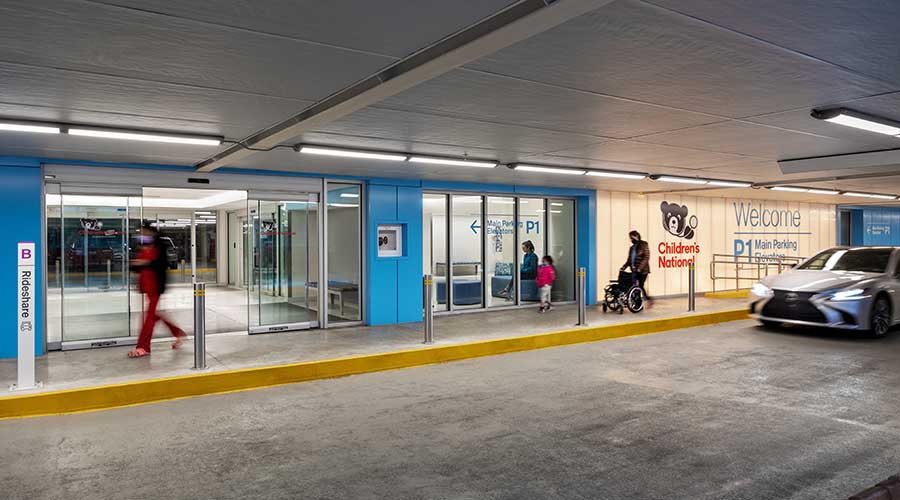National interdisciplinary design firm HGA announced the completion of Children’s National Hospital’s new arrival and patient experience located in Washington, DC. The institution, dedicated to neonatal care, neurosurgery, oncology and other specialties, and sought after by patients and families from all over the nation, needed an upgraded arrival experience.
Prior to the transformation, most patients and their families accessed the 323-bed facility from a sub-level garage, where low ceiling heights caused poor acoustics, low lighting added to heightened anxiety levels and lack of visual wayfinding cues contributed to a feeling of confusion. To create an improved experience, HGA’s integrated internal team of designers, registered nurse and researchers analyzed the patients’ journey through the existing sequence, surveyed families and staff, and developed solutions to create a more hospitable and safer arrival to the hospital.
Features of the fully modernized entrance experience include:
- Vehicular traffic functions, including drop-off, pick-up and ‘kiss and ride’ areas were designed for transparency and ease of flow
- ADA-accessible parking areas were expanded
- Pedestrian circulation routes and entries were separated from staff shuttles for safety and efficiency
Additional improvements include a three-bank elevator system exclusive to visitors, new signage and color-coded floor assignments coordinated with the hospital’s wayfinding improvement project. A grand stairway in warm neutral tones and indirect lighting connects visitors to the main atrium and visitor check-in area.
HGA considered age, cognitive levels, diminished vision, neurodiversity and accessibility when specifying lighting materials, placements and illuminance. Interior lighting was specified with low unified glare ratio (UGR) levels and regressed lighting fixtures infused underground hallways and elevator bays in ways that will not overwhelm children sensitive to light or their surroundings.
The new arrival sequence features a design that is calming and sensory stimulating – together they engage the visitor and help place them at ease. Engaging tactile surfaces now provide positive distractions. They include pops of color along accent walls and a 15-foot-tall structure, provided by RxArt Foundation titled, “Tree to Be Me,” that stands at the base of the stairway. The mixed media work of marble, steel and fabric, created by The Haas Brothers, resembles a “magical beaded palm-tree” and features a “resident monkey” who greets visitors as they ascend the winding staircase.

 UF Health Hospitals Rely on Green Globes to Realize Their Full Potential
UF Health Hospitals Rely on Green Globes to Realize Their Full Potential How Healthcare Facilities Can Be Truly Disaster-Resilient
How Healthcare Facilities Can Be Truly Disaster-Resilient TriasMD Breaks Ground on DISC Surgery Center for San Fernando Valley
TriasMD Breaks Ground on DISC Surgery Center for San Fernando Valley Bigfork Valley Hospital Falls Victim to Data Breach
Bigfork Valley Hospital Falls Victim to Data Breach AI-Driven Facilities: Strategic Planning and Cost Management
AI-Driven Facilities: Strategic Planning and Cost Management